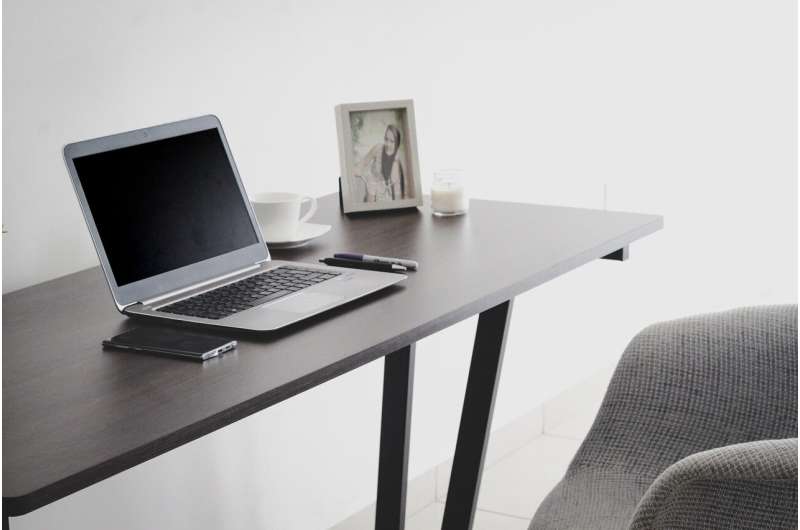This article has been reviewed according to Science X's editorial process and policies. Editors have highlighted the following attributes while ensuring the content's credibility:
fact-checked
trusted source
written by researcher(s)
proofread
Are you sitting too long in your office job? Study offers some health tips

Sedentary behavior can result in chronic health conditions such as obesity and heart diseases, bad news for the millions of office workers who are forced to sit behind their desks every day.
In its simplest form, the term "sedentary behavior" describes sitting for too long and not breaking this up with movement.
Sitting for more than one hour without a break can be considered as too much sitting time.
Existing evidence shows that about 25% of adults and over 75% of adolescents worldwide are not meeting the World Health Organization physical activity recommendations.
The WHO's latest guidelines on physical activity and sedentary behavior recommend physical inactivity by around 15% in all age groups by 2030.
The WHO guidelines, released in 2020, are particularly important for office workers who spend a significant portion of their work day sitting.
As a specialist in the epidemiology of physical activity I took part in a new study into sedentary behavior among a group of office-based workers in South Africa.
We found that conscious movement—even if this means standing instead of sitting—helped office workers stay healthy.
What we found
In our study, published in the American Journal of Lifestyle Medicine, colleagues and I collected data from 122 office workers based in Johannesburg.
The majority of the participants were female (68%) with an average age of 40 years. All had completed high school.
We measured body mass index, waist circumference, blood pressure and other key medical indicators of health and well-being.
Participants were asked to record their own sitting times.
We also used wrist-worn accelerometers to collect data. This innovative method gave us a more accurate understanding of physical activity and sedentary behavior compared to self-reported questionnaires.
The self-reported data by participants averaged 1.3 hours a day sitting for mealtimes, 3.9 hours a day related to work, 1.4 hours a day for transport, 1.7 hours a day for screen time, and 3.4 hours a day for other activities. This amounted to about 12 hours of sitting per day.
This was significantly higher than the three hours a day recorded by accelerometers. The discrepancy could partly be explained by participants—consciously or unconsciously—feeling more motivated to move when wearing these smart devices.
The blood pressure, cholesterol and serum triglyceride levels of our study participants were within normal ranges.
This finding is encouraging because they seemed to be at less risk of cardiovascular diseases. It could possibly be explained by the fact that these office workers were engaged in light physical activity for about two hours a day.
This also supports the WHO's message emphasizing that any movement is better than none.
They engaged in moderate to vigorous physical activity for about 50 minutes a day. This was less than the WHO recommendation of at least 60 minutes of moderate to vigorous physical activity a day.
In terms of overall health for South African office workers, our findings show that conscious efforts to move during the day can help them keep them healthier.
Keep standing and keep moving
Light intensity physical activity, sometimes referred to as gentle exercise, can include movement such as getting up, and walking to make a cup of coffee.
Office workers should stand whenever possible, as there is a growing body of evidence showing that standing is better than prolonged sitting, particularly for energy expenditure and reducing the risk of cardiovascular disease. It also activates muscle activity.
In practical terms, light physical activities during the workday could include:
- standing up to take a break
- using a standing workstation
- standing during meetings.
Moderate to vigorous physical activities could include:
- using the stairs instead of the lifts
- parking further from the office building entrance and walking at a brisk pace to the entrance
- introducing fun activity breaks
- engaging in various types of activities at a private gym close to work.
Office workers should make conscious efforts to engage in physical activities during recreational times.
These could include:
- participating in weekly park runs
- walking groups
- structured sporting activities such as organized cycling, especially with safety and security in mind.
In general, the more physically active people are, the better the health outcomes.
Moving forward
By 2021 worldwide obesity had nearly tripled since 1975.
Physical inactivity is the leading modifiable risk factor for cardiometabolic diseases and all-cause mortality.
Studies such as ours help policymakers, businesses and companies formulate strategies to keep office workers healthier, promote a positive work-life balance and contribute to a more efficient work environment.
Our research underscores the urgent need to include more opportunities for movement into our everyday lives, especially important for South African office workers.
More studies from the global south are needed to develop context-relevant workplace interventions that can be easily integrated into employee health and wellness policy.
This article is republished from The Conversation under a Creative Commons license. Read the original article.![]()



















